
Bernard of Clairvaux, O. Cist., venerated as Saint Bernard, was an abbot, mystic, co-founder of the Knights Templars, and a major leader in the reformation of the Benedictine Order through the nascent Cistercian Order.

The Carthusians, also known as the Order of Carthusians, are a Latin enclosed religious order of the Catholic Church. The order was founded by Bruno of Cologne in 1084 and includes both monks and nuns. The order has its own rule, called the Statutes, and their life combines both eremitical and cenobitic monasticism. The motto of the Carthusians is Stat crux dum volvitur orbis, Latin for "The Cross is steady while the world turns." The Carthusians retain a unique form of liturgy known as the Carthusian Rite.

Grande Chartreuse is the head monastery of the Carthusian religious order. It is located in the Chartreuse Mountains, north of the city of Grenoble, in the commune of Saint-Pierre-de-Chartreuse (Isère), France.
Devotio Moderna was a movement for religious reform, calling for apostolic renewal through the rediscovery of genuine pious practices such as humility, obedience, and simplicity of life. It began in the late 14th-century, largely through the work of Gerard Groote, and flourished in the Low Countries and Germany in the 15th century, but came to an end with the Protestant Reformation. It is most known today through its influence on Thomas à Kempis, the author of The Imitation of Christ, a book which has proved highly influential for centuries. The Devotio Moderna wrote in IJssellands, a written language which stood in between Middle Dutch and Middle Low German.

Christian meditation is a form of prayer in which a structured attempt is made to become aware of and reflect upon the revelations of God. The word meditation comes from the Latin word meditārī, which has a range of meanings including to reflect on, to study, and to practice. Christian meditation is the process of deliberately focusing on specific thoughts and reflecting on their meaning in the context of the love of God.
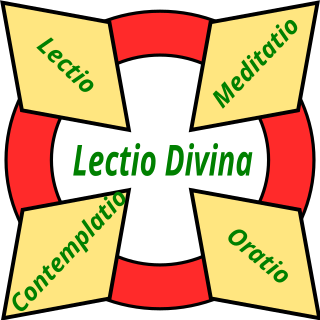
In Western Christianity, Lectio Divina is a traditional monastic practice of scriptural reading, meditation and prayer intended to promote communion with God and to increase the knowledge of God's word. In the view of one commentator, it does not treat Scripture as texts to be studied, but as the living word.
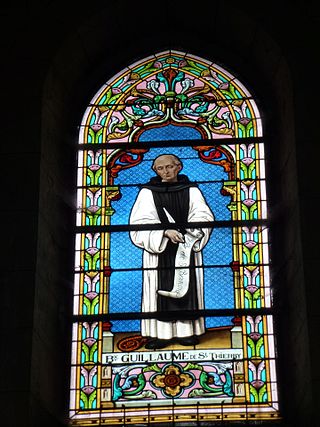
William of Saint-Thierry, O. Cist was a twelfth-century Benedictine, theologian and mystic from Liège who became abbot of Saint-Thierry in France, and later joined the Cistercian Order.
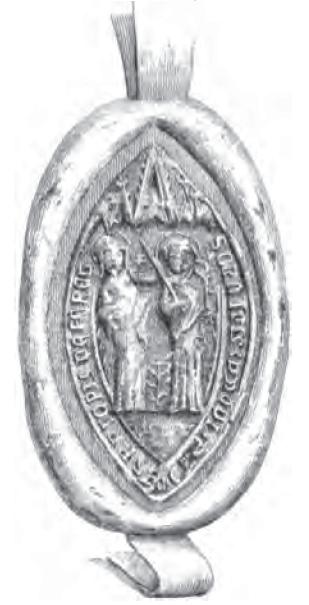
Perth Charterhouse or Perth Priory, known in Latin as Domus Vallis Virtutis, was a monastic house of Carthusian monks based at Perth, Scotland. It was the only Carthusian house ever to be established in the Kingdom of Scotland, and one of the last non-mendicant houses to be founded in the kingdom. The traditional founding date of the house is 1429. Formal suppression of the house came in 1569, though this was not actualised until 1602.

Nicholas Love, also known as Nicholas Luff, was first a Benedictine and then a Carthusian monk in medieval England, and became the first prior of Mount Grace charterhouse in Yorkshire. He was the translator and reviser of a popular devotional treatise which was used by the Church authorities to counter the teaching of John Wycliffe. In his later years he convinced Henry V of England to attempt to reform Benedictine monasticism in England, but died before measures could be taken.
The Chartreuse Notre-Dame des Prés was a Carthusian monastery (Charterhouse) in northern France, at Neuville-sous-Montreuil, in the Diocese of Arras, now Pas-de-Calais.

La Valsainte Charterhouse or La Valsainte situated in La Valsainte in the district of Gruyère, Canton of Fribourg, is the only remaining extant Carthusian monastery in Switzerland.

Guigo II, sometimes referred to as Guy, or by the moniker "the Angelic", was a Carthusian monk and the 9th prior of Grande Chartreuse monastery, from 1174 to 1180.

Marguerite d'Oingt was a French Carthusian nun and celebrated mystic. She was also among the earliest identified women writers of France.
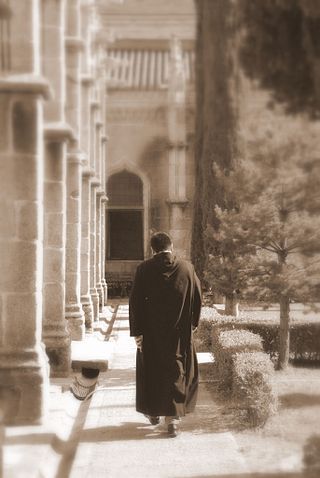
Prayer has been an essential part of Christianity since its earliest days. As the Middle Ages began, the monastic traditions of both Western and Eastern Christianity moved beyond vocal prayer to Christian meditation. These progressions resulted in two distinct and different meditative practices: Lectio Divina in the West and hesychasm in the East. Hesychasm involves the repetition of the Jesus Prayer, but Lectio Divina uses different Scripture passages at different times and although a passage may be repeated a few times, Lectio Divina is not repetitive in nature.
Hugh of Balma, also known as Hugo of Palma or Hugh of Dorche was a Carthusian theologian, is generally acknowledged to be the author of the work which titled Viae Syon Lugent, after its opening line. That work is also known as De Mystica Theologia, De Theologia Mystica and De Triplici Via. It is a comprehensive treatment of the Mystical Theology of Pseudo-Dionysius the Areopagite. The work was attributed to Saint Bonaventure in medieval and early modern times, but this attribution was firmly rejected and attributed to Hugh by the Franciscans of Quaracchi, editors of the critical edition of Bonaventure's work, in 1895.
Guigo de Ponte, also known as Guigues du Pont, was a Carthusian monk of the Grande Chartreuse. Little is known about him, but he probably professed there in 1271, and died in 1297.
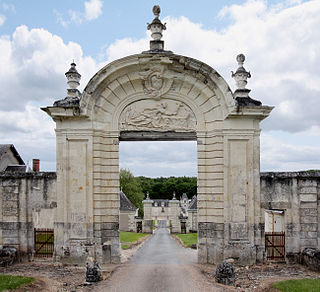
Chartreuse of Liget was a monastery of hermit-monks of the Carthusians order in France, founded in 1178 in Touraine by Henry II, Count of Anjou and King of England, in atonement for the murder of Thomas Becket committed on his command.
Classics of Western Spirituality [CWS] is an English-language book series published by Paulist Press since 1978, which offers a library of historical texts on Christian spirituality as well as a representative selection of works on Jewish, Islamic, Sufi and Native American spirituality. Each volume is selected and translated by one or more scholars or spiritual leaders, with scholarly introductions and bibliographies of both primary and secondary materials. The series contains multiple genres of spiritual writing, including poems, songs, essays, theological treatises, meditations, mystical biographies, and philosophical investigations, and features works by famous authors such as Augustine of Hippo and Martin Luther. As well as lesser-known authors such as Maximus the Confessor and Moses de León.

Molsheim Charterhouse is a former monastery of the Carthusian order, or charterhouse, located in the heart of the town of Molsheim, in the Lower Rhine region of Alsace. It now houses the Musée de la Chartreuse.












